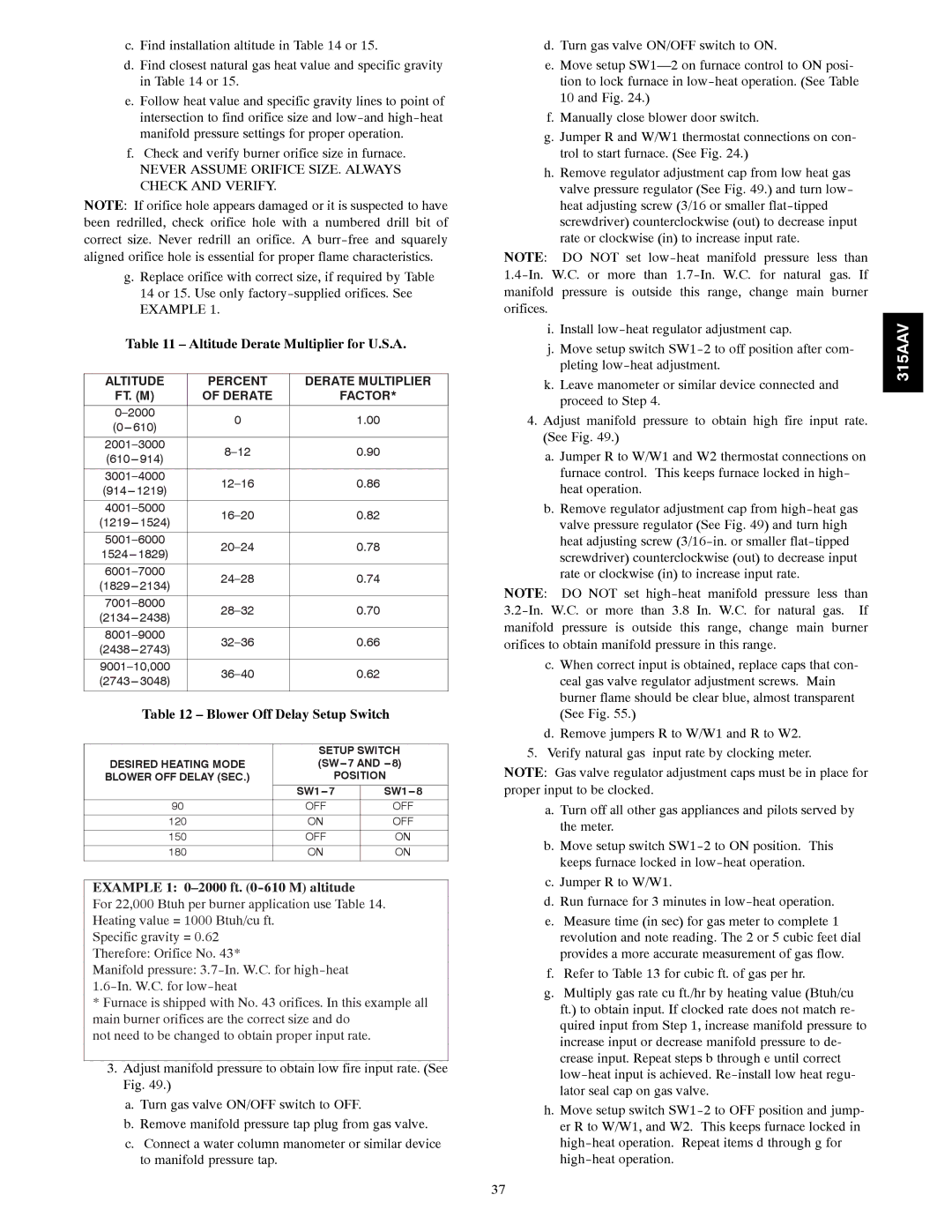
c.Find installation altitude in Table 14 or 15.
d.Find closest natural gas heat value and specific gravity in Table 14 or 15.
e.Follow heat value and specific gravity lines to point of intersection to find orifice size and
f.Check and verify burner orifice size in furnace.
NEVER ASSUME ORIFICE SIZE. ALWAYS CHECK AND VERIFY.
NOTE: If orifice hole appears damaged or it is suspected to have been redrilled, check orifice hole with a numbered drill bit of correct size. Never redrill an orifice. A
g.Replace orifice with correct size, if required by Table 14 or 15. Use only
Table 11 – Altitude Derate Multiplier for U.S.A.
ALTITUDE | PERCENT | DERATE MULTIPLIER | |||
FT. (M) | OF DERATE |
| FACTOR* | ||
0 |
|
| 1.00 | ||
|
| ||||
|
|
|
|
| |
|
|
|
|
|
|
| 0.90 | ||||
| |||||
|
|
|
|
| |
|
|
|
|
|
|
| 0.86 | ||||
| |||||
|
|
|
|
| |
|
|
|
|
|
|
| 0.82 | ||||
| |||||
|
|
|
|
| |
|
|
|
|
|
|
| 0.78 | ||||
| |||||
|
|
|
|
| |
|
|
|
|
|
|
| 0.74 | ||||
| |||||
|
|
|
|
| |
|
|
|
|
|
|
| 0.70 | ||||
| |||||
|
|
|
|
| |
|
|
|
|
|
|
| 0.66 | ||||
| |||||
|
|
|
|
| |
| 0.62 | ||||
| |||||
|
|
|
|
| |
Table 12 – Blower Off Delay Setup Switch | |||||
|
|
|
|
| |
|
|
| SETUP SWITCH | ||
DESIRED HEATING MODE |
| ||||
BLOWER OFF DELAY (SEC.) |
| POSITION | |||
|
|
|
| ||
90 |
|
| OFF |
| OFF |
120 |
|
| ON |
| OFF |
150 |
|
| OFF |
| ON |
180 |
|
| ON |
| ON |
EXAMPLE 1: 0–2000 ft. (0-610 M) altitude
For 22,000 Btuh per burner application use Table 14. Heating value = 1000 Btuh/cu ft.
Specific gravity = 0.62 Therefore: Orifice No. 43*
Manifold pressure:
*Furnace is shipped with No. 43 orifices. In this example all main burner orifices are the correct size and do
not need to be changed to obtain proper input rate.
3.Adjust manifold pressure to obtain low fire input rate. (See Fig. 49.)
a.Turn gas valve ON/OFF switch to OFF.
b.Remove manifold pressure tap plug from gas valve.
c.Connect a water column manometer or similar device to manifold pressure tap.
d.Turn gas valve ON/OFF switch to ON.
e.Move setup
f.Manually close blower door switch.
g.Jumper R and W/W1 thermostat connections on con- trol to start furnace. (See Fig. 24.)
h.Remove regulator adjustment cap from low heat gas valve pressure regulator (See Fig. 49.) and turn low- heat adjusting screw (3/16 or smaller
NOTE: DO NOT set
i.Install
j.Move setup switch
k.Leave manometer or similar device connected and proceed to Step 4.
4.Adjust manifold pressure to obtain high fire input rate. (See Fig. 49.)
a.Jumper R to W/W1 and W2 thermostat connections on furnace control. This keeps furnace locked in high- heat operation.
b.Remove regulator adjustment cap from
NOTE: DO NOT set
c.When correct input is obtained, replace caps that con- ceal gas valve regulator adjustment screws. Main burner flame should be clear blue, almost transparent (See Fig. 55.)
d.Remove jumpers R to W/W1 and R to W2.
5.Verify natural gas input rate by clocking meter.
NOTE: Gas valve regulator adjustment caps must be in place for proper input to be clocked.
a.Turn off all other gas appliances and pilots served by the meter.
b.Move setup switch
c.Jumper R to W/W1.
d.Run furnace for 3 minutes in
e.Measure time (in sec) for gas meter to complete 1 revolution and note reading. The 2 or 5 cubic feet dial provides a more accurate measurement of gas flow.
f.Refer to Table 13 for cubic ft. of gas per hr.
g.Multiply gas rate cu ft./hr by heating value (Btuh/cu ft.) to obtain input. If clocked rate does not match re- quired input from Step 1, increase manifold pressure to increase input or decrease manifold pressure to de- crease input. Repeat steps b through e until correct
h.Move setup switch
315AAV
37
